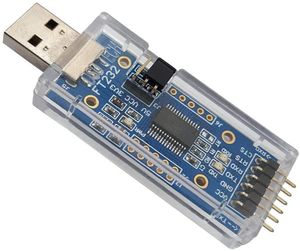TTL Connector for Linksys AC Series Routers
The BEST TTL to Serial Adapter that can be purchased for use with a Linksys AC Series Router is based on an FTDI chipset. Of all the adapters available, the best one is from a company named DSD Tech, model SH-U09C.
And the Serial Header Pin Out chart / diagram in the OpenWRT documentation on the OpenWRT site is incorrect.
Summary
A Brief Orientation
The Issue
The Solution
Product(s) Review
The Journey
More Information
A Brief Orientation
TTL is an acronym for Transistor-Transistor Logic (not Time To Live which is related to DNS). The definition of TTL by Wikipedia doesn't do a great job of explaining how TTL relates to serial communication method that takes place over copper wires. And technically, when referring to a Serial Adapter, the more accurate terms are RS-232 or V.24.
The Linksys AC Series Routers, sometimes referred to as the new WRT Series of routers, consists of several models. They are the WRT1900AC, WRT1900ACS, WRT3200ACM, and WRT32X. Some of the models have additional model designations such as version 1 (v1), version 2 (v2), and references to various other products such as the Microsoft X-Box.
TTL and Serial / COM (AKA RS-232)
A good explanation of Serial Communication along with a comparison between TTL and RS-232 is here: RS232 vs TTL: RS232 vs TTL: Beginner Guide to Serial Communication (the RS-232 VS TTL is at the end of the article) *
The Real Pin # 1
The Issue
The diagram(s) referenced and reused by many, many people for the TTL connector on the Linksys AC Series routers is incorrectly labeled. The numbering of the pins is reversed. Specifically, the numbering showing the pins labeled as 1 through 6, left to right, as looking at the board from the top / front. It should be numbered 6 through 1. Although, the perspective of the diagram could be looking from the top / rear of the board, which would make the numbering correct.
Justification
Many website tutorials, YouTube videos, diagrams, and even images on the OpenWRT website show the TTL Serial Port for the AC series of routers numbered from left to right, starting with "pin 1", as viewed from the top / front of the circuit board. This is NOT correct, although both the names / labels of the pins and what their function is (Ground, TX (Transmit), and RX (Receive)), are correct. It is an industry standard to identify "Pin 1" on a circuit board in several manners. The most common methods includes a triangle printed on the circuit board closest to "Pin 1" and a square solder connection (as viewed from the bottom). Another convention that is typically followed, but is not an absolute rule, is putting "Pin 1" closest to the nearest edge of a circuit board. The AC Series of routers all have a square solder connection on the bottom and a triangle printed on top of the circuit board for "Pin 1" on the right side of the connector, as viewed from the top. Since there is no pin out standard for that type of connector, the manufacturer (Linksys in this case) gets to define where "Pin 1" is located. And per the triangle marking, pin closest to edge, and square solder connection pin number one is located as indicated by the below image. PERIOD.
Respit
This is not intended to be any sort of attack on the nice people who have done all of the difficult work to figure things out, document it, etc. Somewhere along the way, someone made an innocent mistake, and it has been propagated quite a bit. This short diatribe on the Pin # 1 subject is intended to point out the issue in the hope that it may one day be corrected. It's also an interesting lesson in how once incorrect information gets out there, it's difficult to correct.
Side Notes
* As good as the article is, the title really buries the lede: RS232 vs TTL: Beginner Guide to Serial Communication(shouldn't RS232 VS TTL be the first paragraph?). And having a desire to link a reader to the specific text and anchor tag / id was searched for, but didn't exist. Hence the need to reference the pertinent section at the bottom of the article. Without an ID or NAME attribute, there's no way to link to that point on a page. And it's coming from a Word Press site. That brings up the idea of automatic ID tags for posts and pages (and paragraphs as it turns out)
